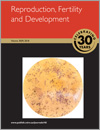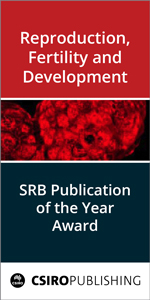Reproduction, Fertility and Development
Volume 30
Number 9 2018
This paper is focused on the ZFY gene in Hu-sheep testis which plays an important role in sex determination and spermatogenesis. We interrupted the Hu-sheep ZFY gene by RNAi and analysed the semen quality, sperm abnormalities, and offspring sex ratio. The function of ZFY gene in Hu-sheep spermatogenesis and reproduction was unearthed by us.
Heat stress has an adverse impact on worldwide cattle reproduction. The oocyte is a major target of heat stress. This study determined the protective effect of astaxanthin on oocytes exposed to heat shock. Astaxanthin restored oocyte developmental competence by decreasing reactive oxygen species and regulating antioxidant enzymes. Astaxanthin supplementation should be studied as a possible thermoprotective strategy in cattle.
Chrysin has been recognized as beneficial for reproduction; however, its effects on the prostate are poorly understood. This morphological study demonstrated that chrysin promoted anabolic effects on the prostate of male and female gerbils, resulting in hyperplastic growth, stromal remodelling and stimulation of the biosynthetic–secretory pathway. Thus, chrysin intake should be considered with caution, since it changes prostate biology.
This study revealed that gonadotrophs express the receptor for anti-Müllerian hormone (AMH) in postpubertal heifers, and that the AMH receptor colocalised with gonadotrophin-releasing hormone receptors on the surface of gonadotrophs. Furthermore, AMH stimulated gonadotrophin secretion from anterior pituitary cells of postpubertal heifers. Therefore, preantral and small antral follicles may secret AMH to control gonadotrophin secretion from gonadotrophs in postpubertal heifers.
Proper oocyte maturation is required to increase the chance of pregnancy. We investigated the improvement in oocyte maturation brought about by β-cryptoxanthin, an antioxidant. The results of the present study may be useful for assisted reproduction techniques in infertility therapy.
Pregnant mice that lack the hormone relaxin have an abnormal cervix and cannot give birth, mainly because there is excess collagen. The aim of this study was to uncover the underlying mechanisms of abnormal cervical remodelling by studying matrix metalloproteinases, enzymes that regulate collagen. We showed that increased cervical collagen in relaxin-deficient mice is not due to deficits in these enzymes, suggesting a different mechanism of relaxin action on collagen in this tissue.
Thyroid hormone (TH) is important for normal reproductive function, and dysregulation of TH impairs ovarian follicular development. The aim of this study was to investigate the effects of TH on cytochrome P450 family 19 expression and steroidogenesis in mouse granulosa cells. The findings will advance the current understanding of the role of TH in the regulation of reproductive function.
Ovarian stimulation is commonly performed during the application of reproductive biotechnologies in live females of monovular species. The aim of this study was to evaluate the effect of four stimulatory protocols on the follicular population and molecular status of cumulus–oocyte complexes in sheep. Gene expression was affected by the different protocols, and the lower FSH dose (80 mg) in multiple applications produced better-quality oocytes.
Proteomic analyses are important for understanding the metabolic pathways underpinning embryo development. This study elucidated the relative abundance of six key glycolytic and glycogenic enzymes at five developmental stages leading to in vitro bovine blastocyst formation. The data suggest a shift around the 16-cell stage from glycolytic-centric to glycogenic-centric metabolism, coinciding with the embryonic genome activation window.
Hyperinsulinaemia can lead to imbalances in lipid metabolism and is related to reproductive disorders. We found that an insulin challenge during the sensitive period of oocyte maturation leads to changes in embryonic gene expression with mechanisms both leading to and against lipid accumulation. Insulin influences lipid metabolism in the early bovine embryo on the gene expression level, whereas the lipid profile seems to be more stable.
Cyclical changes in cervical mucus are indispensable for a woman’s fertility but an exact regulatory mechanism of its secretion has not yet been elucidated. This study demonstrated, for the first time, that elements of the GABA signalling pathway are present in the secretory epithelium of mouse and human cervical tissue. These results strengthened the hypothesis that non-neuronal activity of GABA could be a possible mediator in the regulation of female fertility.




